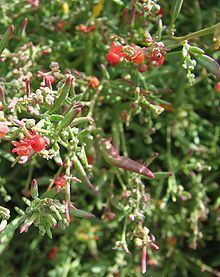Tribe Atripliceae | Subfamily Chenopodioideae Genus Chenopodium Rank Species | |
 | ||
Similar Enchylaena tomentosa, Atriplex semibaccata, Enchylaena, Chrysocephalum apiculatum, Bursaria spinosa | ||
Chenopodium nutans (Syn Einadia nutans, Rhagodia nutans), known by its common name of Climbing Saltbush or Nodding Saltbush, is a climbing groundcover native to Australia.
Plants form a blanket on the surface, climbing over logs and up trees to a height of around 1 metre. Each plant grows to around one metre in diameter. The small leaves are semi-succulent, and have a distinctive arrowhead shape. They grow along long, vine-like branches spreading out form the centre of the plant. Both the leaves and the branches are of a light green colour.
Flowers are inconspicuous green balls, which form on top of terminal spikes during summer. These transform into very conspicuous, tiny, bright-red berries during early autumn.
Human uses
The plant was boiled along with other species of saltbush for use as a greens substitute by early European settlers in the Adelaide region. The plant is easily propagated, making it a particularly attractive and useful plant for revegetation projects. It has recently been enjoying increasing popularity as a garden plant, for its low maintenance, low water usage properties.
